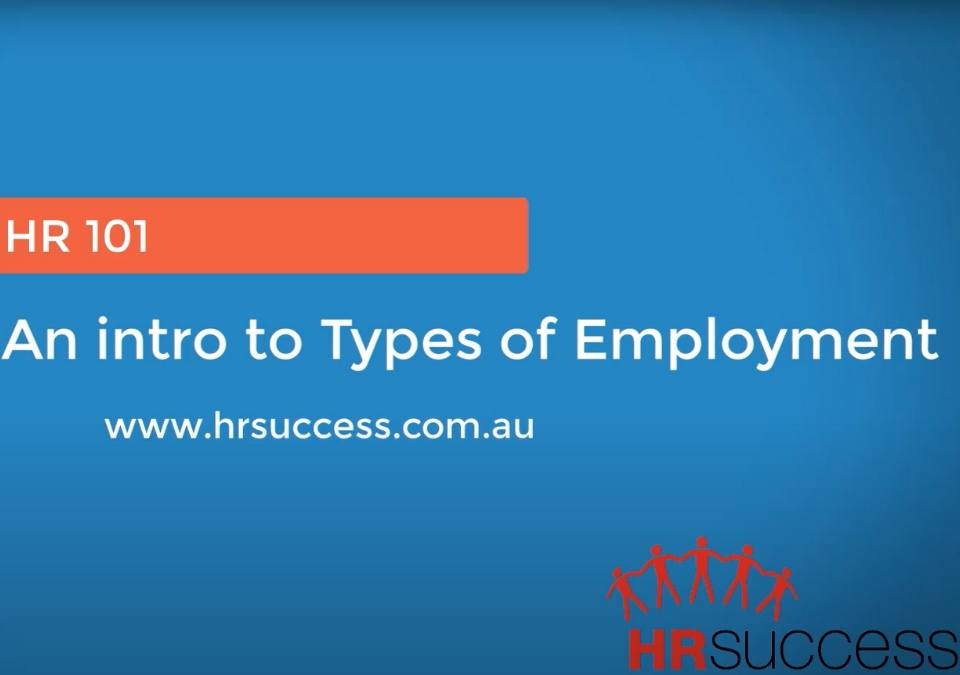This video provides an introduction to the different types of employment: full-time, part-time and casual.
To access the video (on Youtube), click on the image to the left or click HERE. The video transcript is below.
Note: shortly after production of this video (mid-March 2021), the Federal Government made changes to legislation affecting casual employment. Click here to review our blog relating to these important changes.
Let us know if you need further information or support.
Transcript
Hi, Greg Mitchell here.
And today I wanted to chat with you about the different types of employment, the main ones being full time, part time and casual.
We thought this topic may be helpful following a few conversations we’ve recently had with new clients who were somewhat confused by the whole thing to the point that one of them was referring to her “permanent casuals” and her “part time casuals”, and another said that all of her team were casuals, though some of them get paid leave and some of them don’t.
A quick disclaimer, though. While today will identify the key types of employment and the key conditions that generally apply to each type, it needs to be noted that they don’t necessarily apply in all cases. Different arrangements might apply, for example, to employees under certain awards or to those not covered by an award. So please regard this as general information only. It’s not legal or professional advice. If you need guidance related to your specific circumstances, please give us a call or send us an email. We’d be happy to help.
So let’s get into it.
Generally speaking, at the time of engaging an employee, you need to determine whether they are going to be a full time employee, a part time employee or a casual employee.
Full time employees are engaged to work 38 hours per week on an ongoing basis. Note that it’s not 37.5 hours and it’s not 40 hours per week. It’s 38 hours per week.
That said, full time employees can be directed to work “reasonable additional hours”. What’s reasonable depends on a range of factors, including the remuneration the person receives and the nature and seniority of the role, for example.
If you’re paying a person the minimum award rate, it’s unlikely that any additional hours will be deemed reasonable, unless of course, they’re compensated for in the form of overtime.
Full time employees have full entitlements to paid leave as per the National Employment Standards and/or any applicable award, agreement or contract.
Generally, that means 4 weeks paid annual leave plus annual leave loading, 10 days personal/carers leave, long service leave and so on.
Part time employees are those engaged to work less than 38 hours per week on an ongoing basis.
They also have access to paid leave, such as annual, personal/carers and long service leave, though on a pro-rata basis that’s consistent with their hours of work.
A few other important things to note about part timers.
Most awards include provision for a minimum number of hours per shift for part timers. It’s usually somewhere in the range of 2 to 4 hours, but check the appropriate award for details.
Also, most, though not all awards, require the employer and their part time employee to agree in writing on the number of hours to be worked each day, the days of the week on which the employee will work, and the times at which the employee will start and finish work on each day.
Most, though again not all awards, also require that work performed outside of these agreed days and times be paid as overtime payments.
This is a really important point, which in our experience is often missed by small businesses.
So let’s go through a simple example.
Jane’s engaged as a part time admin person with a small local business. She and the owner have agreed and documented that her work hours are Tuesday, 9am to 5pm and Wednesday 9am to 12pm. So once we take out her lunchtime on the Tuesday, that’s about 10 hours per week.
This week, some extra adjustments need to be made to the payroll, so the owner has asked Jane to work a full day on the Wednesday rather than her usual half day. Under the Clerk’s Award, unless other arrangements have been made, Jane would in this case be entitled to overtime payments on the additional hours worked beyond her usual half day, even though she’s still only worked 14 hours or so in the week.
In the course of this example, I mentioned the possibility of other arrangements being made.
Most awards do include provisions allowing the employer and/or the employee to vary previously agreed arrangements as to the days and times of work. So it’s not a case of you just need to live with whatever agreement was made at the time of the person’s initial engagement.
Changes can generally be made, but there are strict provisions around the nature of those changes, the process by which those changes can be made and the notice period required.
There may also be an opportunity where you are paying a sizeable over-award payment or where you enter into an Individual Flexibility Agreement with the employee, to vary those strict award requirements. But these need careful consideration and you may need to seek professional support to ensure you get the documentation right.
Keep in mind that part timers are also entitled to public holidays off if they fall on a day on which they would normally work.
The final type of employment we’re looking at today is casual employment.
The original intention of casual employment was to provide a means for employers to engage people on an “as needs” basis, to help them manage the peaks and troughs of their business.
Each engagement of a casual employee was regarded as a separate and distinct period of employment, and there was generally no expectation of regular or ongoing employment.
While in a legal sense, casual employment is still largely regarded in this way, the actual way in which many employers and their casual employees work together has changed somewhat over the years, which has led to some pretty significant challenges for a number of employers.
The bottom line is that it’s important for employers to correctly identify their non full time employees as casual or part time and manage them accordingly.
Other than long service leave (yes, casuals can be entitled to long service leave if they’re there for long enough), casuals are not entitled to access paid leave.
In lieu of their entitlement to paid annual leave and personal/carer’s leave and other benefits such as notice of termination, casuals are entitled to a casual loading on top of their hourly pay rate.
The loading amount is generally 25%.
A relatively recent change, which again in our experience is not so well known by small business employers, is that most casual employees engaged under an award now have the right to request conversion to part time or full time employment if, in the preceding 12 months, they worked a pattern of hours that is ongoing and reasonably reflective of full or part time employment.
The employer in this case is required to consult with the employee about any such request and can only refuse the request on “reasonable grounds”. Reasonable grounds, for example, might include an expectation of the employer that the pattern of hours the employee has been working for the last 12 months is not likely to continue for some reason.
There’s also a requirement in most awards that casual employees be informed within 12 months of their first engagement of their right to request casual conversion after 12 months.
A couple of additional points to note regarding casual employees.
Similarly to part time employees, most awards include a minimum shift provision for casuals. Again, it’s usually between 2 and 4 hours.
Casual employees may also have an entitlement to overtime payments under certain conditions, so be sure to check your award for specific details.
I appreciate that I’ve shared a lot of information with you today and some of it is perhaps not easy to digest. The key message we’d like you to take away, though, is: be aware of your responsibilities as an employer;be sure to correctly classify your employees as full time, part time or casual; actively manage your team and rostering in accordance with requirements depending on whether they are full time, part time or casual; be sure to get the documentation right and please seek professional support if you need it.
We’d welcome your comments or questions.
Thanks for watching and cheers to your success.

